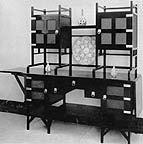


A sampling of Victorian chairs to show the range of furniture styles during the age of Victoria. [Click on thumbnails for larger images and additional information about these objects.]
 hat did the Victorians
like? What kind of furniture, silverwork, jewelry, wallpaper, and glass
did they buy for their own homes? Even to begin to answer that
question one must put the terms "Victorian" and "Victorians" within
quotation marks twice — first because the Victorian years, which lasted
from 1835 (or even 1830) to 1903 or a few years beyond, obviously
divides into three, four, or even five periods. Whereas the early part
of Victoria's reign saw interest in a medieval
or Gothick Revival in all aspects of architecture and design, much of
the mid- and late-Victorian period was a time of the lush, abundant, cluttered look that most of us
associate with the term "Victorian." Then, from the 1880s onward, a
series of reactions against High Victorian taste took place —
Aestheticism, Art Nouveau, Japonisme, the
Arts and Crafts movement, the Celtic Revival and the Liberty style, and finally Art Deco,
which reached its height much later, in the 1930s and '40s. Therefore,
when anyone talks about "Victorian taste," we have to find out to which
part of Victoria's reign they refer.
hat did the Victorians
like? What kind of furniture, silverwork, jewelry, wallpaper, and glass
did they buy for their own homes? Even to begin to answer that
question one must put the terms "Victorian" and "Victorians" within
quotation marks twice — first because the Victorian years, which lasted
from 1835 (or even 1830) to 1903 or a few years beyond, obviously
divides into three, four, or even five periods. Whereas the early part
of Victoria's reign saw interest in a medieval
or Gothick Revival in all aspects of architecture and design, much of
the mid- and late-Victorian period was a time of the lush, abundant, cluttered look that most of us
associate with the term "Victorian." Then, from the 1880s onward, a
series of reactions against High Victorian taste took place —
Aestheticism, Art Nouveau, Japonisme, the
Arts and Crafts movement, the Celtic Revival and the Liberty style, and finally Art Deco,
which reached its height much later, in the 1930s and '40s. Therefore,
when anyone talks about "Victorian taste," we have to find out to which
part of Victoria's reign they refer.




A sampling of Victorian cabinets and shelving to show the range of furniture styles during the age of Victoria. [Click on thumbnails for larger images and additional information about these objects.]
Second and equally important, Victorian taste varied widely according to social class and the not-always-closely-related matter of economic status. To begin with, many members of the nobility and land-owning gentry, who lived in homes their families had occupied for centuries, found themselves surrounded by Elizabethan, Jacobean, and eighteenth-century furnishings, and unless they were self-consciously interested in contemporary taste, they were often unlikely to replace perfectly good furniture or silver, however old and out-of-fashion, with any examples of new taste. A conservative, prosperous, but not particularly wealthy member of the squierarchy, like Ralph Carbury of Trollope's The Way We Live Now, had no fashionable furnishings. Similarly, members of the working classes, farm workers, and unemployed poor, who together made up far more than half of the Victorian population, did not have the resources to furnish their homes with properly Victorian things.



A sampling of Victorian tables to show the range of furniture styles during the age of Victoria. [Click on thumbnails for larger images and additional information about these objects.]
By and large, then, questions of Victoran taste refer primarily to the middle and professional classes, to factory owners in the industrial North, such the Thorntons we meet in Gaskell's North and South, and a very view wealthy trendsetters — the kind of people we see made the subject of Punch's mockery.
Related Materials
- Review of Deborah Cohen's Household Gods: The British and Their Possessions
- Review of Kathryn Ferry's The Victorian Home
- Review of Judith A. Neiswander's The Cosmopolitan Interior: Liberalism and the British Home, 1870-1914
- Victorian taste, industrial design, and Victorian locomotives
Suggested Readings
Cohen, Deborah. Household Gods: The British and Their Possessions. New Haven and London: Yale University Press, 2006. 296 + xvii pp. ISBN 0-300-11213-0
Cooper, Jeremy. Victorian and Edwardian Furniture and Interiors. London: Thames and Hudson, 1987.
Ferry, Katherine. The Victorian Home. Botely, Oxford: Shire Books, 2010. 112pp. ISBN 978-0-74780-748-3.
Gloag, John. Victorian Comfort: A Social History of Design, 1830-1900. A. C. Black, 1961. (Reprinted 1973 by David and Charles, Newton Abbot.)
Levy, Mervyn. Liberty Style, The Classic Years, 1798-1910. New York: Abrams, 1986.
Naylor, Gillian. The Arts and Crafts Movement: A Study of Its Sources, Ideals, and Influence on Design Theory. Cambridge: MIT Press, 1971.
Last modified 10 June 2024